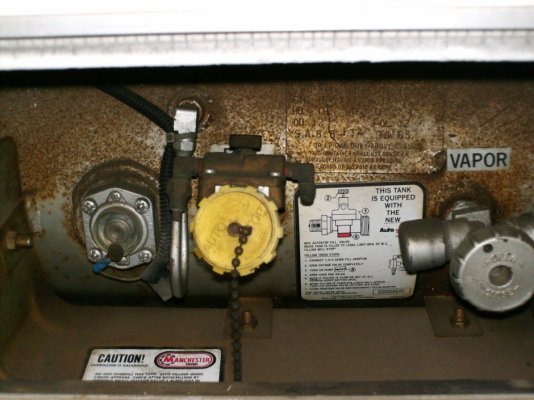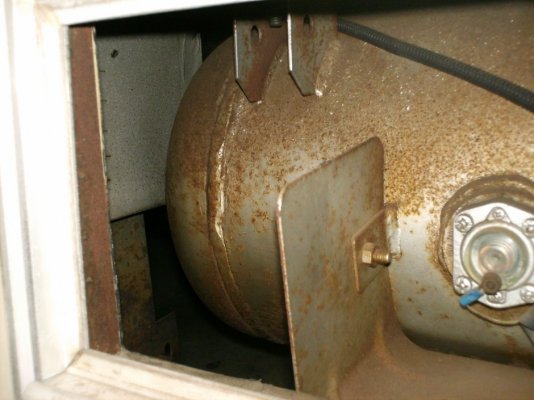You are using an out of date browser. It may not display this or other websites correctly.
You should upgrade or use an alternative browser.
You should upgrade or use an alternative browser.
Does this LP tank need to be replaced? (pic)
- Thread starter RV
- Start date
The friendliest place on the web for anyone with an RV or an interest in RVing!
If you have answers, please help by responding to the unanswered posts.
If you have answers, please help by responding to the unanswered posts.
DAN L
Well-known member
you could wire brush the tank and see how deep the rust goes. :-\
if it is just surface rust and you decide to paint it, use something like rustoleum aluminum reflective paint. a light colored reflective paint is required on propane tanks.
if it is just surface rust and you decide to paint it, use something like rustoleum aluminum reflective paint. a light colored reflective paint is required on propane tanks.
Gary RV_Wizard
Site Team
You are on your way to some deep rust pits. I think I would promptly wire brush/sand it and re-paint as Dan suggested. However, a replacement tank would not be a bad idea either if the budget allows. After all, it's 22+ years old now.
KIX
Active member
If it were my tank????
I would remove it from the coach, wire brush it well, prime it with a primer compatible with automotive paints. Top coat with a good automotive type paint. A better choice for top coat may be a marine top coat that has good non-scuff characteristics. ONe that comes to mind is Awl-Grip. But there are others too. KIX
I would remove it from the coach, wire brush it well, prime it with a primer compatible with automotive paints. Top coat with a good automotive type paint. A better choice for top coat may be a marine top coat that has good non-scuff characteristics. ONe that comes to mind is Awl-Grip. But there are others too. KIX
Jammer
Well-known member
- Joined
- Dec 20, 2009
- Posts
- 1,491
Looks fine to me. The ASME tanks are thick.
Fred G.
Well-known member
Looks better than mine and mine has just been re-certified. ;D
Mark R.
Well-known member
That is nothing more then a fine surface rust,this is a modern tank and complies with the latest rules, replacing it would be throwing money out the vent window. I removed my tank, sanded it and welded a broken support, re painted and replaced, looks like new and is better then new, removing a empty tank can be a a pain removing a full tank will be a pain, sanding tank when installed will be a pain, sanding the tank removed is least painful but reinstalling without scratching your new paint will be a pain. Pick your pain! 
D
Dave W
Guest
Surface rust. I would have it recertified then would then, if it passes, then repaint with a good automotive epoxy primer and a good top coat to prevent the primer from chalking and you should be good for another 20 years. New hoses, whichever way you go, recetified or new, are a good idea as wells the will and have hardened/cracked over the years.
jjhoneck
Member
RV said:Just wondering if the rust on this tank is bad enough that you would replace the tank if it were yours. It's in a 1987 Fleetwood Tioga, no idea if it's the original tank but probably so.
Mine looked far worse when we acquired our MH last fall. It was only rusted on the bottom, from road chips, etc.
I wire brushed it, then washed it down with water. After thoroughly drying it off, I hit it with multiple coats of naval jelly. Although it's not as good as the original stuff (that the EPA probably banned), it still works to convert rust to an inert substance.
After that, I hit it with two coats of Rust-O-Leum paint, followed by a final coat of white enamel.
Jammer
Well-known member
- Joined
- Dec 20, 2009
- Posts
- 1,491
I guess I didn't realize that there was any recertification of ASME tanks that took place. The certification lasts "forever" even if the tank does not. Isn't it just the portable DOT tanks with the 12 year/5 year limits that get this treatment?
1275gtsport
Well-known member
not sure if it is the same everywhere. however, I have a 1974 Rockwood Motorhome. I took the tank off during the rebuild 2 summers ago. moved it over to the corner of the yard and left it for the winter (3 feet of snow covered it) then in the spring took it to the propane place. asked to have it recertified and he looked at me funny. no such thing exists for the asme tank (under body) what we did do was replace the cracked feed hose and broken regulator. the sad part was releasing the half a tank of fuel to replace the regulator. the tech advised to give a good coat of paint and to change the hose every 10 or so years. now if you had the WHOLE system apart like I did THEN you have to have that reinstalled and Verified by a Certified propane dude. this we did (after I put the tank back on.) I also coated the tank (being careful not to get any on the hoses) with a rubberized rock guard.
Thanks for all the replies, everybody. Looks like the consensus is that it might still have some life in it if I clean it up & paint it, so I think I'll go that route for now & see if I can get a bit more use out of it, maybe keep my eye out for a deal on a replacement eventually. I'll give her a new regulator & hoses while I'm at it; that might be even more important.
Thx,
Bob
Thx,
Bob
DAN L
Well-known member
RV said:Thanks for all the replies, everybody. Looks like the consensus is that it might still have some life in it if I clean it up & paint it, so I think I'll go that route for now & see if I can get a bit more use out of it, maybe keep my eye out for a deal on a replacement eventually. I'll give her a new regulator & hoses while I'm at it; that might be even more important.
Thx,
Bob
be careful not to empty the tank completely so as to possibly introduce air and moisture into the tank.
If I remove the regulator to replace it, will the tank stay sealed or will that open it up to the atmosphere?DAN L said:be careful not to empty the tank completely so as to possibly introduce air and moisture into the tank.
Jammer
Well-known member
- Joined
- Dec 20, 2009
- Posts
- 1,491
The relief valve is plumbed directly to the tank without a shutoff. Should it be necessary to replace it, the tank would have to be emptied. They last a very long time so this should be an unusual occurrence, indeed.
Regulators connect to even the largest tanks using the same POL fitting we were accustomed to with portable tanks prior to the acme threads introduced around the same time as the OPD valves. Closing the tank valve allows the regulator to be replaced without any loss of propane (to speak of). There might be tanks out there that don't have a valve upstream of the regulator, but I've never seen one.
Regulators connect to even the largest tanks using the same POL fitting we were accustomed to with portable tanks prior to the acme threads introduced around the same time as the OPD valves. Closing the tank valve allows the regulator to be replaced without any loss of propane (to speak of). There might be tanks out there that don't have a valve upstream of the regulator, but I've never seen one.
Master-Tech
Well-known member
Ever have a Propane Leak ? Most leaks are just Vapor and HIGHLY FLAMABLE ! But think about Pure LIQUID VERY DANGEROUS DID I SAY VERY ! You stand a chabce too lose your Coach urself an loved ones , im just being honest, Go too ur Propane Distributor - have them pressure chech it an ull know then ; most all Tanks have too be re-certified after so mkany years , if not they are NOT SUPPOSED TO FILL THEM REGUARDLESSS OFF THE PAINT JOB !! Oh by the way that date code is FEDERALLY MANDATED , so have em check it 4 your on SAFTEY ! Please , Hope this tid bit Helps , Rodney Service Manager 8 Years Technician 12
D
Dave W
Guest
Here's some good reading rather then listen to other's opinions (including mine 
 ).
).
http://www.propane101.com/index.htm
http://www.propane101.com/index.htm
Jammer
Well-known member
- Joined
- Dec 20, 2009
- Posts
- 1,491
Master-Tech said:Ever have a Propane Leak ? Most leaks are just Vapor and HIGHLY FLAMABLE ! But think about Pure LIQUID VERY DANGEROUS DID I SAY VERY ! You stand a chabce too lose your Coach urself an loved ones , im just being honest, Go too ur Propane Distributor - have them pressure chech it an ull know then ; most all Tanks have too be re-certified after so mkany years , if not they are NOT SUPPOSED TO FILL THEM REGUARDLESSS OFF THE PAINT JOB !! Oh by the way that date code is FEDERALLY MANDATED , so have em check it 4 your on SAFTEY ! Please , Hope this tid bit Helps , Rodney Service Manager 8 Years Technician 12
I've read of ASME tanks developing leaks but it's rare and the only reports of that I've seen were on the Westfalia forum and I'm not convinced of their reliability (for example, the leak may have been in the regulator or piping. Propane leaks can be extremely hard to isolate in some cases). My house is served by a tank manufactured in 1960 and I have every reason to believe it will last many more years.
The wall thickness on ASME tanks is much higher than DOT tanks. It is not unusual to see 1/4" thick steel walls. This is why they don't have to be recertified.


